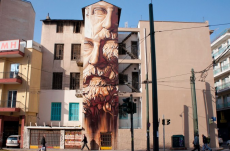
We’ve all heard of Banksy, but did you know that there are many more street artists in lots of countries around the world? The trouble is, many people associate graffiti with gang culture, and it is an offence under the Criminal Damage Act 1971. Under this act, a perpetrator of graffiti can be fined up to £5000, or sentenced to community service. Graffiti is defined as drawings, scribbles or writings which are applied directly to walls and surfaces. Posters which are put up without the wall owner’s permission are still illegal but come under the definition of “fly posting”, which is treated less severely.
We are all familiar with the spray paint marking of initials or swearwords in dodgy underpasses. These tend to make the environment more threatening, and local councils do their best to prevent such vandalism by using surfaces resistant to paint. Another notable feature of this kind of graffiti is the complete lack of any artistic talent required to do them.
More rare is the spraying of complicated “graffiti tag names” in a unique fashion, which graffiti artists use to identify their work, without risking a court appearance. There are many websites which show you how to create a tag name, but the essence is to make it short, and to choose one with letters you can make interesting – it’s like the artist’s personal logo, so it’s important.
It’s pretty clear that unskilled scrawling is vandalism. Nobody likes to look at it, and it makes the environment seem dangerous and dirty. Graffiti used to cover the subway trains in New York in the 1970’s and later on, but more recently greater security means that the trains have less graffiti. However, this has been replaced by “scrachiti”, or lines etched into the train windows in the shape of tags and things that used to be done with spray paint.
Graffiti is often used to make a political point – everything from scrawled slogans to Banksy’s clever social comments. Athens, struggling with economic problems and unemployment, has seen a boom in “street art” to express political views or just to brighten the scene. But the portrait of Plato shown in the picture must one of the best examples of street art ever.
In short the answer to the question “is graffiti art or vandalism” really depends on the quality of the art. It’s important to realise that if the owner of the property does not want it and has not given permission for its creation, ultimately even the most brilliant artwork is illegal.
In 2013, New York mayor Michael Bloomberg, stated that Banksy was defacing other peoples’ property during his one month stay in New York, when he created a new piece in a different location every day. Fans who chased all over the city to see his work disagreed, as did some of the property owners who decided they would sell the artwork on their doors, etc.
So, if you are planning to do it, practice on paper until your art is good and then ask permission – you might be surprised by the reception you get.

0 Comment:
Be the first one to comment on this article.